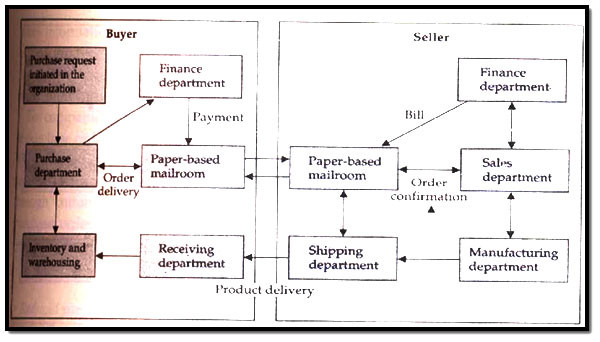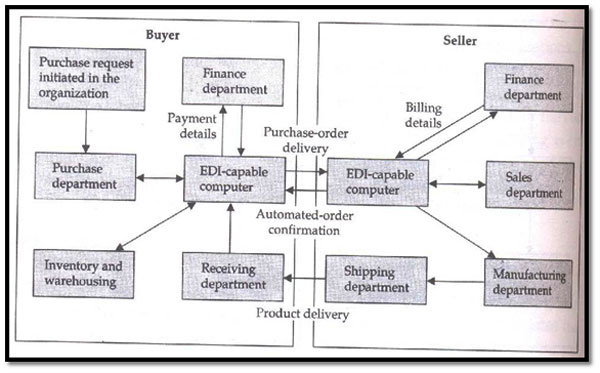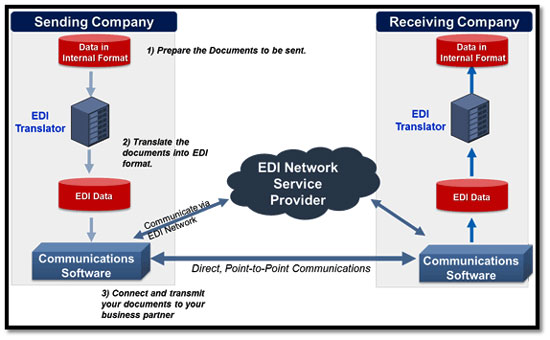Unit- IV
Sakshi Education

Electronic Data Interchange
Electronic Data Interchange (EDI) - interposes communication of business information in standardized electronic form. Prior to EDI, business depended on postal and phone systems that restricted communication to those few hours of the workday that overlap between time zones. EDI plays major role to:
EDI & Electronic Commerce
Electronic commerce includes EDI & much more. EDI forges boundary less relationships by improving interchange of information between trading partners, suppliers, & customers
Benefits of EDI
EDI layered architecture
EDI semantic layer:
Standards translation:
EDI: Legal, Security, & Privacy Issues
Legal Status of EDI Messages
To understand the legal framework, let’s take a look on three modes of communication types:
Digital Signatures & EDI
EDI & Electronic Commerce
New types of EDI are:
Traditional EDI
It replaces the paper forms with almost strict one-to-one mappings between parts of a paper form to fields of electronic forms called transaction sets. It covers two basic business areas:
Old EDI
In this automating the exchange of information pertinent to business activity is achieved. It is referred as the current EDI-standardization process where it allows every company to choose its own, unique, proprietary version
New EDI
It is refocusing of the standardization process. In this, the structure of the interchanges is determined by the programmer who writes a program. It removes long standardization process.
Open EDI
It is a business procedure that enables e-commerce to occur between organizations where the interaction is of short duration. It is process of doing EDI without the upfront trading partner agreement that is currently signed by the trading partners. The goal is to sustain ad hoc business or short-term trading relationships using simpler legal codes. It is a law of contract within the context of e-commerce where transactions are not repeated over long period of time.
Standardization & EDI
Standards translation
This specifies business form structure so that information can be exchanged. Two competing standards are:
Structure of EDI transactions
Comparison of EDIFACT & X.12 Standards
EDI Software Implementation
EDI software has 4 layers:
EDI Business Application Layer
EDI Envelope for Message Transport
The X.400 & X.435 Envelopes
EDI Software Implementation
The X.435 inserts a special field in an X.400 envelope to identify an EDI message. It includes data encryption; integrity; notification of message delivery & non-delivery; & non-repudiation of delivery. It is secure, reliable way to send EDI & accompanying files within the same message. Purchase orders, invoices, drawings, e-mail- all could be sent with end-to-end acknowledgment of message receipt.
Value-Added Networks (VANs)
Internet-Based EDI
Several factors make internet useful for EDI:
Electronic Data Interchange (EDI) - interposes communication of business information in standardized electronic form. Prior to EDI, business depended on postal and phone systems that restricted communication to those few hours of the workday that overlap between time zones. EDI plays major role to:
- Reduction in transaction costs
- Foster closer relationships between trading partners
EDI & Electronic Commerce
Electronic commerce includes EDI & much more. EDI forges boundary less relationships by improving interchange of information between trading partners, suppliers, & customers
Benefits of EDI
- Cost & time savings, Speed, Accuracy, Security, System Integration, Just-In-Time Support.
- Reduced paper-based systems, i.e. record maintenance, space, paper, postage costs
- Improved problem resolution & customer service
- Expanded customer/supplier base or suppliers with no EDI program lose business
EDI layered architecture
- Semantic (or application) layer
- Standards translation layer
- Packing (or transport) layer
- Physical network infrastructure layer
Figure: EDI layered architecture
EDI semantic layer:
- Describes the business application
- Procurement example
- Requests for quotes
- Price quotes
- Purchase orders
- Acknowledgments
- Invoices
- Specific to company & software used
Standards translation:
- Specifies business form structure so that information can be exchanged
- Two competing standards
- American National Standards Institute (ANSI) X12
- EDIFACT developed by UN/ECE, Working Party for the Facilitation of International Trade Procedures
EDI transport layer- How the business form is sent, e.g. post, UPS, fax
- Increasingly, e-mail is the carrier
- Differentiating EDI from e-mail
- Emphasis on automation
- EDI has certain legal status
Physical network infrastructure layer- Dial-up lines, Internet, value-added network, etc.
EDI in Action- The fig shows the information flow when paper documents are shuffled between organizations via the mailroom
- When the buyer sends a purchase order, then relevant data extracted & recorded on a hard copy.
- This hard copy is forwarded to several steps, at last manually entered into system by the data entry operators
- This process is somewhat overhead in labor costs & time delays.

Figure: Information Flow without EDI
EDI in Action- Information flow with EDI are as follows:
- Buyer sends purchase order to seller computer
- Seller sends purchase order confirmation to buyer
- Seller sends booking request to transport company
- Transport company sends booking confirmation to seller
- Seller sends advance ship notice to buyer
- Transport company sends status to seller
- Buyer sends Receipt advice to seller
- Seller sends invoice to buyer
- Buyer sends payment to seller EDI as a fast, inexpensive & safe method

Figure: Information Flow with EDI
Benefits of EDI- Cost & time savings, Speed, Accuracy, Security, System Integration, Just-In-Time Support.
- Reduced paper-based systems, i.e. record maintenance, space, paper, postage costs
- Improved problem resolution & customer service
- Expanded customer/supplier base or suppliers with no EDI program lose business
EDI Applications in Business
Four different scenarios in industries that use EDI extensively:- International or cross-border trade
- Electronic funds transfer
- Health care EDI for insurance claims processing
- Manufacturing & retail procurement
- International or cross-border trade
- EDI has always been very closely linked with international trade.
- Trade efficiency, which allows faster, simpler, broader & less costly transactions
Role of EDI in international trade- EDI facilitates the smooth flow of information
- It reduces paper work
- EDI benefits for international trade are:
- Reduced transaction expenditures
- Quicker movement of imported & exported goods
- Improved customer service through “track & trace” programs
- Faster customs clearance & reduced opportunities for corruption, a huge problem in trade
- Interbank Electronic Funds Transfer (EFT)
- EFTS is credit transfers between banks where funds flow directly from the payer’s bank to the payee’s bank.
- The two biggest funds transfer services in the United States are the Federal Reserve’s system, Fed wire, & the Clearing House Interbank Payments System (CHIPS) of the New York clearing house
Automated Clearinghouse (ACH) Transfers- ACH transfers are used to process high volumes of relatively small-dollar payments for settlement in one or two business days
- It provides services: preauthorized debits, such as repetitive bill payments; & consumer-initiated payments.
- Health care EDI for insurance EDI
- Providing good & affordable health care is a universal problem
- EDI is becoming a permanent fixture in both insurance & health care industries as medical provider, patients, & payers
- Electronic claim processing is quick & reduces the administrative costs of health care.
- Using EDI software, service providers prepare the forms & submit claims via communication lines to the value-added network service provider
- The company then edits sorts & distributes forms to the payer. If necessary, the insurance company can electronically route transactions to a third-party for price evaluation
- Claims submission also receives reports regarding claim status & request for additional information
- Manufacturing & retail procurement using EDI
- These are heavy users of EDI
- In manufacturing, EDI is used to support just-in-time.
- In retailing, EDI is used to support quick response
Just-In-Time & EDI- Companies using JIT & EDI calculates how many parts are needed each day based on the production schedule & electronically transmit orders.
- Delivery has to be responsive, or it will cost too much in money & time.
- Getting data to suppliers quickly
- A major benefit of JIT & EDI is a streamlined cash flow.
Quick Response & EDI- For the customer, QR means better service & availability of a wider range of products
- For the retailer & supplier, QR may mean survival in a competitive marketplace
- Much focus of QR is in reduction of lead times using event-driven EDI.
- In QR, EDI documents include purchase orders, shipping notices, invoices, inventory position, catalogs, & order status
EDI: Legal, Security, & Privacy Issues
Legal Status of EDI Messages
To understand the legal framework, let’s take a look on three modes of communication types:
- Instantaneous. If the parties are face to face or use an instantaneous communication medium such as the telephone
- Delayed (USPS). The “mailbox rule” provides that an acceptance communicated via USPS mail is effectively when dispatched
- Delayed (non-USPS). Acceptances transmitted via telegram, mailgram, & electronic messages, are communicated & operable upon receipt.
Digital Signatures & EDI
- Digital signatures might be time-stamped or digitally notarized to establish dates & times
- If digital signatures are to replace handwritten signatures, they must have the same legal status as handwritten signatures.
- It provides a means for a third party to verify that notarized object is authentic.
EDI & Electronic Commerce
New types of EDI are:
- Traditional EDI
- Open EDI
Traditional EDI
It replaces the paper forms with almost strict one-to-one mappings between parts of a paper form to fields of electronic forms called transaction sets. It covers two basic business areas:
- Trade data Interchange (TDI) encompasses transactions such as purchase orders, invoice & acknowledgements.
- Electronic Funds Transfer (EFT) is the automatic transfer of funds among banks & other organizations
It is divided into 2 camps: old EDI & new EDI. Old EDI is a term created by those working on the next generation of EDI standards in order to differentiate between the present & the future.
Old EDI
In this automating the exchange of information pertinent to business activity is achieved. It is referred as the current EDI-standardization process where it allows every company to choose its own, unique, proprietary version
New EDI
It is refocusing of the standardization process. In this, the structure of the interchanges is determined by the programmer who writes a program. It removes long standardization process.
Open EDI
It is a business procedure that enables e-commerce to occur between organizations where the interaction is of short duration. It is process of doing EDI without the upfront trading partner agreement that is currently signed by the trading partners. The goal is to sustain ad hoc business or short-term trading relationships using simpler legal codes. It is a law of contract within the context of e-commerce where transactions are not repeated over long period of time.
Standardization & EDI
Standards translation
This specifies business form structure so that information can be exchanged. Two competing standards are:
- American National Standards Institute (ANSI) X12
- EDIFACT developed by UN/ECE, Working Party for the Facilitation of International Trade Procedures
Structure of EDI transactions
- Transaction set is equivalent to a business document, such as a purchase order
- Data Segments are logical groups of data elements that together convey information
- Data elements are individual fields, such as purchase order no.
Comparison of EDIFACT & X.12 Standards
- These are comprised of strings of data elements called segments.
- A transaction set is a set of segments ordered as specified by the standard.
- ANSI standards require each element to have a very specific name, such as order date or invoice date.
- EDIFACT segments, allow for multiuse elements, such as date.
- EDIFACT has fewer data elements & segments & only one beginning segment (header), but it has more composites.
- It is an ever-evolving platform
EDI Software Implementation
EDI software has 4 layers:
- Business application
- Internal format conversion
- EDI Translator
- EDI envelope for document messaging
These 4 layers package the information & send it over the value-added network to the target business, which then reverses the process to obtain the original information
EDI Business Application Layer
- It creates a document, an invoice.
- Sends to EDI translator, reformats the invoice into an EDI standard.
- If there are on the same type of computer, the data move faster

EDI Envelope for Message Transport
The X.400 & X.435 Envelopes
- The X.400 standard was meant to the universal answer to e-mail interconnectivity
- It promises much & to date, delivers little.
- The work on X.400 began in1980
- It is the open standard for mail interchange
- The standard exists in 3 versions: 1984, 1988, & 1992.
EDI Software Implementation
The X.435 inserts a special field in an X.400 envelope to identify an EDI message. It includes data encryption; integrity; notification of message delivery & non-delivery; & non-repudiation of delivery. It is secure, reliable way to send EDI & accompanying files within the same message. Purchase orders, invoices, drawings, e-mail- all could be sent with end-to-end acknowledgment of message receipt.
Value-Added Networks (VANs)
- A VAN is a communication network that typically exchanges EDI messages among trading partners.
- It provides services, including holding messages in “electronic mailboxes”, interfacing with other VANs
- Disadvantage is EDI-enabling VANs is that they are slow & high-priced, charging by the no. of characters transmitted

Figure: Functions of a Third party VAN
Internet-Based EDI
Several factors make internet useful for EDI:
- Flat-pricing that is not dependent on the amount of information transferred
- Cheap access with low cost of connection- often a flat monthly fee for leased line 0r dial-up access
- Common mail standards & proven networking & interoperable systems
- Security- public-key encryption techniques are being incorporated in various electronic mail systems
Published date : 27 Jul 2015 12:17PM






